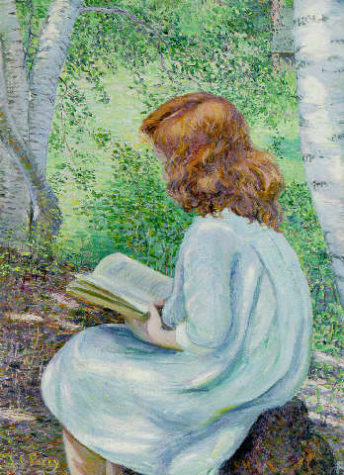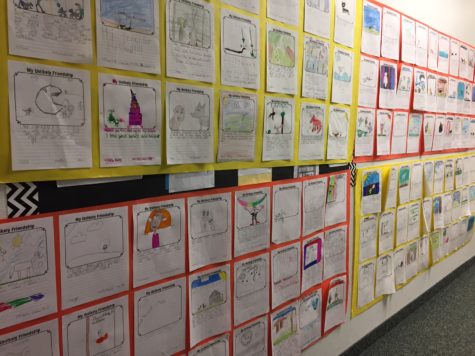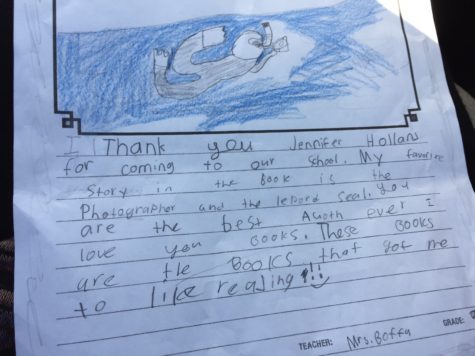
The girl sits on the edge of the chair with her knees pressed together, hands twisting in her lap and chin jutting out slightly. Her braids are tight and smooth, hanging just past her shoulders and secured with matching red bands. A little comic strip kid, neatly drawn, eyes big and sparkling.
“I can’t believe it’s you,” she keeps saying. “I’m so honored to meet you.” She smiles and smiles some more. Then: “You’re my favorite author!”
I am tempted to turn around to see the great scribe about whom this precious girl is gushing. But oddly, she is staring up at me.
It’s me! I’m her favorite author!
Instead, for my book tours I visit elementary schools. One after another. Hundreds of kids file into cafeterias and libraries and auditoriums just to hear me talk about how much I love animals, to tell stories about my experiences. I try to sneak some science into my talks—about what makes wolves different from dogs, about the panda’s unique digestive system, about the medicinal value of reptile venom, for example. And I talk about the science of emotions—the brain structures that make us feel and that we share with other mammals. Geeky stuff that I hope they’ll tell their parents at dinner when asked “what did you learn today?”

It’s pretty easy to keep their attention, actually, because with rare exception the kids I meet love animals. They definitely respond to the cuteness factor (as we are programmed to do) but it seems to go well beyond that. Animals and kids have a lot in common–curiosity and playfulness are two big things—which I think helps them to bond. Children can learn gentleness by handling animals, and empathy by interacting with them. Our pets can be great models of how to love unconditionally, how not to judge others. And I think young people take lessons from animals more readily than they might from a tedious human—a teacher or, God forbid, a parent.
But I digress. The important thing here is, because they love animals and I talk about animals (and show pictures of animals), they listen to me. They want to get my autograph, to hug me. (Should I be concerned that a lot of the huggers are middle-school boys? Probably.) A few of them want to be me.
It’s a peculiar feeling. A good one, of course, but strange nonetheless. I’m no rock star. Other than my old-lady knees and moody gut, I still feel like a kid myself, and, as many writers do, I feel like a fraud much of the time—having somehow convinced my audience that I know what I’m doing. Really I’m your average something-aged woman with dark roots and eye bags and probably something from lunch caught in my teeth. I’m just lurching along with eyes shut and fingers crossed, like most people.
Then there’s the guilt. My audiences give me celebrity treatment and sometimes I’m a stone inside because I’m so damn tired…all this smiling and spouting encouragement is kicking my ass because this is the 12th school I’ve visited in three days and kids are so shrill and needy and sticky and covered in germs. Plus, they can’t wait to share their stories: Her guinea pig sleeps with her gerbil and his dog licks his face when he’s sad—which is very cute except I asked if they had QUESTIONS, QUESTIONS, which aren’t stories but the things that cause your voice to rise at the end so the other person knows it’s time to ANSWER.
Yet, while up there, in front of those kids, I keep reminding myself: They like me so I have the opportunity to shape their minds, to embed information that might actually stick. Maybe I can even change their behavior toward animals or toward each other, or get them more excited about reading and writing. That’s adult-level responsibility, and sometimes I actually like to play grownup. Meanwhile, whatever subject I broach—often the state of animals in the wild—I do my best to tell them the truth without blackening their sweet little souls.
I recall being that age and having favorite books, favorite authors, that meant so much to me. Remember reading the same book over and over? Now I do that only by mistake, getting half way through a novel before noticing how familiar it is…turns out I read it six months earlier. But my elementary and middle-school selves would return to books on purpose, obsessing over favorite passages until I could close my eyes and recite them aloud.
Tucked away somewhere are my most worn-out paperbacks: Charlotte’s Web, the Velveteen Rabbit, Black Beauty, Island of the Blue Dolphins. Plus dog-eared copies of books by James Harriot, Jack London, C.S. Lewis. Is the common theme obvious enough? If I’d met those authors-on-animals as a 4th grader, I might have peed in my pants with excitement. That’s just the kind of weak-bladdered kid I was, one on whom good writing, especially about our relationship to nonhuman creatures and the natural world, had a powerful effect.
And now, for some kids, I’m that bladder-loosening author. I’ve had students come up to tell me things they’ve learned from my work, and parents tell me my books are what got a non-book-loving kid to start reading. Which are awesome things to hear. Meanwhile, I’ve noticed that adult aud iences can be intimidating, all serious faced with the occasional “tell me something I don’t already know” look. They may slump in their chairs but their expectations are sky high. Under such scrutiny, my fraud self quivers in my boots. Kids, on the other hand, just take it all in. Their faces are open and they’re trusting and excited. They compliment my boots. They don’t question how I know what I know; they just want me to give it all to them—with cute pictures to back it up. And then they want a hug.
iences can be intimidating, all serious faced with the occasional “tell me something I don’t already know” look. They may slump in their chairs but their expectations are sky high. Under such scrutiny, my fraud self quivers in my boots. Kids, on the other hand, just take it all in. Their faces are open and they’re trusting and excited. They compliment my boots. They don’t question how I know what I know; they just want me to give it all to them—with cute pictures to back it up. And then they want a hug.
Which is why when that little girl gazed up at me with eyes that I swear were filled with tiny silver stars—so thrilled that she couldn’t stop her legs from vibrating—my return smile, the 746th of the afternoon, was the real thing.
—
Top photo credit: “Child with red hair reading,” by Lilla Cabot Perry (1848-1933), via Wikimedia Commons
One thought on “Thanks, Kids”
Comments are closed.